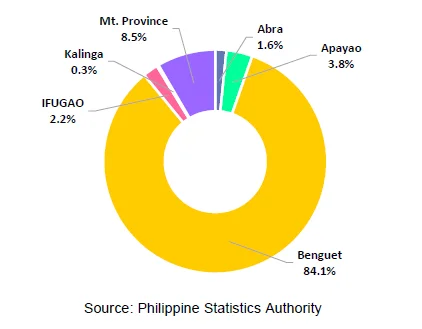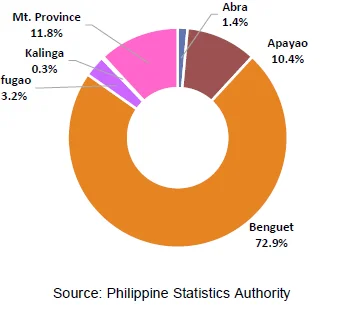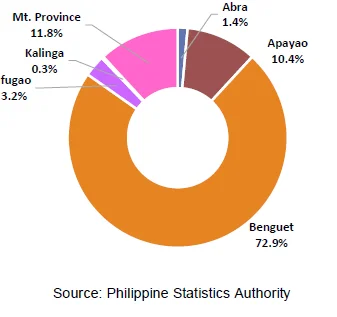The Philippine Statistics Authority (PSA) generates production-related statistics on crops other than palay and corn through the Crops Production Survey (CrPS). This is a quarterly survey which aims to generate basic production statistics for crops at the national and sub-national levels. Twenty-one (21) major crops under the Other Crops sub-sector are highlighted in the Performance of Philippine Agriculture Report (PAR). It covers more than 280 crops sub-classified under three commodity groupings, namely: 1) Non-Food and Industrial Crops, 2) Fruit Crops, and 3) Vegetables. The commodity coverage by province differs and depends on what each province produces. After the collection and organization of statistics on Other Crops, these undergo a review and validation process before finally made available to data users.
Table 1. Major and Priority Vegetables Production by Province, CAR: CY 2019-2020
| Region/Province | Production (MT) | % Change | |
| 2019 | 2020 | ||
| CAR | 368,608.2 | 366,314.6 | (0.06) |
| Major | 129,516.7 | 130,537.8 | 0.8 |
| Priority | 239,091.5 | 235,776.8 | (1.4) |
| Abra | 5,863.2 | 5,836.7 | (0.5) |
| Major | 3,972.6 | 1,882.8 | (0.4) |
| Priority | 3,958.2 | 3,953.9 | (0.5) |
| Apayao | 13,985.3 | 15,102.7 | 8.0 |
| Major | 12,698.9 | 13,586.4 | 7.0 |
| Priority | 1,286.4 | 1,516.30 | 17.9 |
| Benguet | 308,218.6 | 305,052.7 | (1.0) |
| Major | 94,261.6 | 95,149.1 | 0.9 |
| Priority | 213,957.0 | 209,903.6 | (1.9) |
| Ifugao | 8,130.8 | 6,771.1 | (16.7) |
| Major | 5,358.4 | 4,122.0 | (23.1) |
| Priority | 2,772.4 | 2,649.1 | (4.4) |
| Kalinga | 959.6 | 1,038.2 | 8.2 |
| Major | 341.8 | 362.9 | 6.2 |
| Priority | 617.8 | 675.2 | 9.3 |
| Mountain Province | 33,132.2 | 31,609.7 | (4.6) |
| Major | 14,965.6 | 15,434.6 | 3.1 |
| Priority | 18,166.6 | 16,175.1 | (11.0) |
- The vegetables production of the Cordillera Administrative Region (CAR) slightly decreased by (0.6) % from 368,608.2 MT in 2019 to 366,314.6 MT in 2020. Abra, Benguet, Ifugao, and Mt. Province registered negative growths while, Apayao and Kalinga increased in production (Table 1).
Table 2. Distribution of Total Vegetables Production by Province, CAR: CY 2020
| Region/Province | Production (MT) | % to Total |
| CAR | 366,314.6 | 100.0 |
| Major | 130,537.8 | 35.6 |
| Priority | 235,776.8 | 64.4 |
| Abra | 5,836.7 | 1.6 |
| Major | 1,882.8 | 0.5 |
| Priority | 3,953.9 | 1.1 |
| Apayao | 15,107.2 | 4.1 |
| Major | 13,586.4 | 3.7 |
| Priority | 1,516.3 | 0.4 |
| Benguet | 305,052.7 | 83.3 |
| Major | 95,149.1 | 26.0 |
| Priority | 209,903.6 | 57.3 |
| Ifugao | 6,771.1 | 1.8 |
| Major | 4,122.0 | 1.1 |
| Priority | 2,649.1 | 0.7 |
| Kalinga | 1,038.2 | 0.3 |
| Major | 4,122.0 | 1.1 |
| Priority | 675.2 | 0.2 |
| Mountain Province | 31,609.7 | 8.6 |
| Major | 15,434.6 | 4.2 |
| Priority | 16,175.1 | 4.4 |
- Out of the 2020 total regional production of 366,314.6 MT, 235,776.8 MT (64.4%) came from priority vegetables and 130,537.8 MT (35.6%) came from major vegetables production (Table 2).
-
Benguet was the top producer with 305,052.7 MT accounting a lion’s share of 83.3% of the total regional vegetables production. Mountain Province distantly came second with 8.6% share, followed by Apayao with 4.1%, Ifugao with 1.8%, and Abra with 1.6% shares, respectively (Figure 1).
-
Kalinga contributed the smallest share in the total vegetables production of the region with an output of 1,038.2 MT comprising 0.3 % of the total vegetables production in the region (Table 2).
Figure 1. Percentage Distribution of Total Vegetables Production in
CAR by Province: 2020

MAJOR VEGETABLE CROPS
- Major vegetable crops include mongo, ampalaya, cabbage, eggplant, tomato, potato, onion, camote and cassava.
- Cordillera major vegetables output in 2020 was 130,537.8 MT comprising 35.6% of the total vegetables production of the region.
Table 3. Major Vegetables Production by Province, CAR: CY 2020
| Region/Province | Production (MT) | % Share |
| CAR | 130,537.8 | 100 |
| Abra | 1,882.8 | 1.4 |
| Apayao | 13,586.4 | 10.4 |
| Benguet | 95,149.1 | 72.9 |
| Ifugao | 4,122.0 | 3.2 |
| Kalinga | 362.9 | 0.3 |
| Mountain Province | 15,434.6 | 11.8 |
Figure 2. Percentage Distribution of Major Vegetables Production
in CAR by Province: 2020

- Benguet was consistently the top major vegetables producing province with 95,149.1 MT of produce, comprising 72.9% of the major vegetables production. Mt. Province followed with 11.8% share. Apayao and Ifugao came third and fourth with 10.4% and 3.2% shares. The provinces with the smallest shares were Abra and Kalinga with 1.4% and 0.3% shares, respectively (Figure 2).
Table 4. Vegetables Production and Area Harvested by Province, CAR: CY 2020
| Region/Province | Production (MT) | Area Harvested (Has) |
| CAR | 366,314.6 | 23,559.6 |
| Abra | 5,836.7 | 636.0 |
| Apayao | 15,102.7 | 721.6 |
| Benguet | 305,052.7 | 17,408.0 |
| Ifugao | 6,771.1 | 1,499.5 |
| Kalinga | 1,038.2 | 234.2 |
| Mountain Province | 32,513.2 | 3,056.4 |
- In 2020, CAR total vegetables production registered a volume of 366,314.6 MT with an estimated area harvested of 23,559.6 hectares. Priority vegetables dominated the region’s production accounting for 64.4% of the total vegetables production.
- Benguet province posted the highest volume of vegetables produced with 305,052.7 MT from an area harvested of 17,408.0 hectares. Mt. Province came second with 32,513.2 MT with an area harvested of 3,056.4 hectares while Kalinga had the least production in the region with only 1,038.2 MT with an area harvested of 234.2 hectares (Table 4).
Figure 3. Percentage Distribution of Priority Vegetables
Production in CAR by Provine: CY 2020

PRIORITY VEGETABLE CROPS
- Priority vegetable crops include habitchuelas, banana blossom, broccoli, cauliflower, kangkong, lettuce, pechay, peanut, stringbeans, gourd, okra, squash fruit, ginger, pepper, carrots, gabi, radish and garlic.
- In terms of percentage distribution in priority vegetables production in the region, Benguet contributed 83.3%. Mt. Province came second with 8.9% share. The other provinces and their shares to total priority vegetables production were Apayao with 4.1%; Ifugao with 1.8%; and Abra with 1.6%. Kalinga province had the smallest share of 0.3% (Figure 3).



